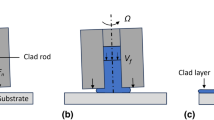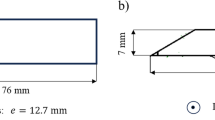Abstract
A new structure of grooved fixture with a cambered surface is proposed to reduce wear of bar surface caused by a fixture in low-stress cropping. Using the finite element method (FEM) and orthogonal experiment, the optimal contact parameter combination of cambered grooving fixture is obtained. The radial wear degree is proposed to evaluate the surface quality of bars under four contact conditions. Results show that the friction pair under the A4B1C2D1E4 combination of contact parameters has the best wear reduction effect and the lowest radial wear degree, which is 0.0469 mm2, and 34.50% lower than ones of line contact, respectively. The cropping platform based on acoustic emission-stress–strain is established to study the influence of roughness Ra on the comprehensive wear state of friction pair. It is pointed out that under the different contact conditions, when Ra = 0.4 μm, the acoustic emission characteristic parameters meet the minimum level and the comprehensive abrasion state of the friction pair is optimal.


















Similar content being viewed by others
Data availability
All authors declare that all data and materials in this manuscript are transparently available.
Code availability
Not applicable.
References
Yao FS (2011) Advanced manufacturing technology. Tsinghua University Press, Beijing
Hu YM, Hua L (2006) Forging process and mold design. China Forestry Publishing House, Beijing
Zhang LJ, Zhang DP, Wang HX, Zhao SD, Li NM (2018) Research on variable frequency-loading curve in precision cropping system with high speed and centrifugal action. Int J Adv Manuf Tech 97(5):2969–2978. https://doi.org/10.1007/s00170-018-1999-5
Zhang LJ, Chen XF, Wang HX, Zhao SD, Li NM, Zhang DP (2018) Research on critical loading force in prec-ision cropping system based on hydraulic compensation. Int J Mech Sci 142–143:44–50. https://doi.org/10.1016/j.ijmecsci.2018.04.039
Zhang LJ, Zhang JW, Jin YS, Chen XF, Zhang DP, Ren YJ, Wang HX, Liu YX (2020) Influence of eccentric incision on crack initiation and propagation of metal bars. J Cent South Univ 51(05):1245–1254. https://doi.org/10.11817/j.issn.1672-7207.2020.05.009
Chen XF, Zhang LJ, Zhang DP, Wang XQ, Wang HX, Liu YX, Liu YH (2018) Influence rule of loading parameters on crack initiation at the tip of V-shaped notch of bars based on XFEM. J Plast Eng 25(04):254–261. https://doi.org/10.3969/j.issn.1007-2012.2018.04.037
Xiao P, Xiong X, Ren YY (2006) Effect of braking speed on friction properties of C/C-SiC composites. Tribology 26(1):12–17. https://doi.org/10.3321/j.issn:1004-0595.2006.01.003
Zhang LJ, Zhao SD, Wang ZW, Liu J (2014) Investigation on the crack initiation of V-shaped notch tip in precision cropping. Adv Mater Sci Eng 2014:1–8. https://doi.org/10.3969/j.issn.1004-132X.2020.04.006
Zhang LJ, Han L, Zhang DX, Li ZH, Zhang JW, Jin YS, Wang HX (2019) Friction and wear characteristics and mechanism analysis of load and nano MoS2 additive on circular hammerhead-bar. Tribology 39(06):777–785. https://doi.org/10.16078/j.tribology.2019128
Zhang LJ, Han L, Zhang DX, Zhang JW, Zhang XQ, Zhang X, Xiang HF (2020) Tribological performance analysis of circular hammerhead-bar friction pair in precision blanking. China Mech Eng 31(04):410–416, 424. https://doi.org/10.3969/j.issn.1004-132X.2020.04.006
Li J, Li CS, Duan ZY (2021) Effect of MoS2-Ag-V2O5 on friction and wear properties of nickel-based composites. Powder Metall Techno 39(2):141–146. https://doi.org/10.19591/j.cnki.cn11-1974/tf.2019120008
Gong TM, Yao PP, Xiao YL, Fan KY, Tan HQ, Zhang ZY, Zhao L, Zhou HB, Deng MW (2015) Wear map for a copper-based friction clutch material under oil lubrication. Wear 328–329:270–276. https://doi.org/10.1016/j.wear.2015.02.055
Mukhacheva TL, Belkin PN, Dyakov IG, Kusmanov SA (2020) Wear mechanism of medium carbon steel after its plasma electrolytic nitrocarburising. Wear 462–463(203516):1–11. https://doi.org/10.1016/j.wear.2015.02.055
Medabalimi SR, Ramesh MR, Kadoli R (2021) Developing partially oxidized NiCr coatings using the combined flame spray and plasma spray process for improved wear behaviour at high temperature. Wear 478–479(203885):1–11. https://doi.org/10.1016/J.WEAR.2021.203885
Lu JH, Li YF, Wang Y, Fu YW (2018) Effect of pre-impregnated organosilicon layer on friction and wear properties of paper-based friction materials. Wear 416–417:6–13. https://doi.org/10.1016/j.wear.2018.09.009
Slawomir W, Waldemar K, Pawel P (2020) The effect of graphite surface texturing on the friction reduction in dry contact. Tribol Int 151:106535. https://doi.org/10.1016/j.triboint.2020.106535
Li HY, Jia YL, Zhang D, Liu HY (2016) Heat production characteristic of power lithium iron phosphate batteries. Chin J Power Sources 40(5):968–970,1083. https://doi.org/10.3969/j.issn.1002-087X.2016.05.008
Wang RQ, Li YT (2019) Wear of hot extrusion die for large diameter thick-walled pipes. J Mech Eng 55(10):70–76. https://doi.org/10.3901/JME.2019.10.070
Xiang G, Han YF, He T, Wang JX, Xiao K (2020) A dynamic wear model for micro-grooved water-lubricated bearings under transient mixed lubrication condition. J Tribol 142(7):1–30. https://doi.org/10.1115/1.4046175
Zhang W, Wang BS, Wang Y, Riccio A (2018) Elastic analysis of nonhomogeneous frozen wall under nonaxisymmetric ground stress field and in state of unloading. Adv Mater Sci Eng 2018:1–13. https://doi.org/10.1155/2018/2391431
Wen SZ, Huang P, Tian Y, Ma YR (2018) Principles of tribology. Tsinghua University Press, Beijing
Yu HL, Wang HM, Yin YL, Song ZY, Zhou XY, Ji XC, Wei M, Shi PJ, Bai ZM, Zhang W (2021) Tribological behaviors of natural attapulgite nanofibers as an additive for mineral oil investigated by orthogonal test method. Tribol Int 153(106562):1–11. https://doi.org/10.1016/j.triboint.2020.106562
Jia XH, Guo F, Huang L, Richard FS, Wang YM (2013) Parameter analysis of the radial lip seal by orthogonal array method. Tribol Int 64:96–102. https://doi.org/10.1016/j.triboint.2013.03.005
Walker JC, Cinti S, Kamps TJ, Mitchell-Smith J, Clare AT (2019) Influence of contact zone on the sliding friction and wear behaviour of an electrochemical jet textured Al-Si alloy. Wear 426–427:1336–1344. https://doi.org/10.1016/j.wear.2019.01.008
Egidijus K, Rostislav C, Miloslav L, Jiři K (2021) Sensitivity analysis of the influence of particle dynamic friction, rolling resistance and volume/shear work ratio on wear loss and friction force using DEM model of dry sand rubber wheel test. Tribol Int 156(106853):1–14. https://doi.org/10.1016/J.TRIBOINT.2021.106853
Fan YB, Gu FS, Ball A (2009) Modelling acoustic emissions generated by sliding friction. Wear 268(5):811–815. https://doi.org/10.1016/j.wear.2009.12.010
Puliyakote S, Singanamalli AV, Balasubramaniam K (2014) Use of acoustic emission in lubrication monitoring in internal combustion engines. Insight 56(1):22–24. https://doi.org/10.1016/j.wear.2019.203108
Yang N, Tao JS, Fu SL, Yang BH, Wang H, Guo WJ, Xu JY, Zhang LJ (2021) Research on the deflection of metal bar with V-shaped notch in low-stress cropping process. Theor Appl Fract Mec 114:1–12. https://doi.org/10.1016/j.tafmec.2021.103017
Xu FW, Fu R, Fan JH, Wang YM, Li WJ (2017) Mechanics of materials. Southeast University Press, Nanjing
Pan S, Zhao CC, Wei PB, Ren FZ (2019) Sliding wear of CoCrNi medium-entropy alloy at elevated temperatures: wear mechanism transition and subsurface microstructure evolution. Wear 440–441(203108):1–13. https://doi.org/10.1016/j.wear.2019.203108
Duan Y, Qu SG, Jia SY, Li XQ (2021) Evolution of wear damage in gross sliding fretting of a nitrided high-carbon high-chromium steel. Wear 464–465(203548):1–13. https://doi.org/10.1016/j.wear.2020.203548
Belkhir N, Bouzid D, Herold V (2007) Correlation between the surface quality and the abrasive grains wear in optical glass lapping. Tribol Int 40(3):498–502. https://doi.org/10.1016/j.triboint.2006.05.001
Funding
The author wishes to express gratitude to the National Natural Science Foundation of PR China (approval no. 51575532) and the Postgraduate Innovation Project Foundation under grant no. YCX2021082, which has supported this work.
Author information
Authors and Affiliations
Contributions
Weijian Guo: conceptualization, writing—original draft, and methodology. Hang Wang: software. Jishao Tao: data curation. Ning Yang: visualization. Bohan Yang: investigation. Shulin Fu: formal analysis. Jiayi Xu: validation. Tao Liu: software. Linhan Gou: investigation. Lijun Zhang: data curation, supervision, and funding acquisition supervision.
Corresponding author
Ethics declarations
Ethics approval
Not applicable.
Consent to participate
All authors consent to their participation in the research of this manuscript.
Conflict of interest
The authors declare no competing interests.
Additional information
Publisher's Note
Springer Nature remains neutral with regard to jurisdictional claims in published maps and institutional affiliations.
Highlights
• A new fixture with cambered surface grooves for low-stress cropping is proposed.
• The radial wear degree is proposed to evaluate the wear characteristic of the metal bar.
• Radial wear degree under optimal combination is the minimum, which is 0.0469 mm2.
• AE parameters are used to study the effect of roughness on the wear state of a friction pair.
Rights and permissions
About this article
Cite this article
Guo, W., Wang, H., Tao, J. et al. Influence of contact parameters on the wear characteristics of fixture-bar friction pair in low-stress cropping. Int J Adv Manuf Technol 121, 4725–4743 (2022). https://doi.org/10.1007/s00170-022-09668-1
Received:
Accepted:
Published:
Issue Date:
DOI: https://doi.org/10.1007/s00170-022-09668-1




